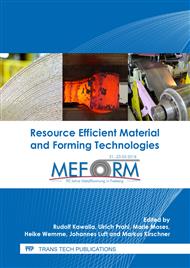p.34
p.40
p.48
p.54
p.65
p.71
p.77
p.85
p.95
Experimental Evaluation of Cold Forging Lubricants Using Double-Cup-Extrusion-Tests
Abstract:
Cold forging processes enable the economical production of high quality components like joints, shafts and gears. The manufactured parts are characterized by improved properties such as hardness, surface quality and fatigue strength. For manufacturing components using cold forging, a comprehensive knowledge regarding the cold forging procedure and its process parameters is needed. One important influencing factor, which needs to be analyzed to use the potential of this kind of processes, is the tribological system, especially the used lubricant. The tribological conditions significantly influence the material flow and thus the workpiece quality. Furthermore, resource efficient and environmentally benign metal forming processes became very important within the last decade. The present study evaluates the resulting tribological conditions and their differences for various cold forging lubricants with and without a zinc phosphate based lubricant carrier. The lubricants are based on molybdenum disulphide, polymers, or both inorganic salts and waxes. The tribological conditions of the different lubricants are investigated using the Double-Cup-Extrusion-Test (DCET) as a laboratory friction test.
Info:
Periodical:
Pages:
65-70
Citation:
Online since:
March 2018
Authors:
Keywords:
Permissions:
Share:
Citation:


